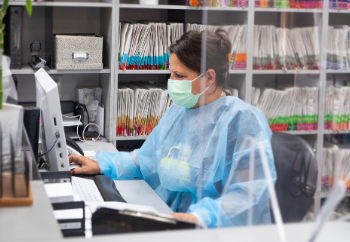What Your Clinic Must Know About Privacy and Contact Tracing
January 11, 2021

The pandemic has created many new obstacles for clinics to overcome, especially with how we are managing the traffic within the office. These obstacles have also brought on new obligations including that of contact tracing.
As of January 1, 2021, Alberta Health Services (AHS) stated they would notify close contacts of positive COVID-19 cases for health care workers, minors, and individuals living or working in communal facilities. This means, Albertans not within these three priority groups who have tested positive for COVID-19 must contact their own close contacts.
What does this mean for clinics?
Community-based clinics, just like any business, are responsible for contacting anyone who might have a close contact within their office. This includes patients and anyone they brought as a support person, employees and colleagues, and any vendors such as delivery personnel, paper shredding companies, etc.
Tracking Visitors
Keeping a Contact Tracing Day Sheet at reception is the best way to track all individuals who come in and out of the clinic. Even if the individual is not the one seeing a provider or they’re just dropping something off, it is imperative that they sign in and out.
Informing Visitors
Under the Personal Information Protection Act (PIPA), clinics must inform individuals why they are collecting certain information, what they are using the data for, and who they will be disclosing it to. The best way to display this message is a Contact Tracing Notification Poster at the check in station or front door. A common Notice of Collection poster can be modified but be sure to include:
What you are requiring of patients and visitors. Some examples are:
- Masks must be worn
- COVID-19 questionnaires must be completed
- Temperature checks are being performed
Confidentiality and Privacy
It’s important to remember that a day sheet is collecting personal information which falls under the PIPA legislation. Follow these steps to keep the information as private as possible:
- Collect the least amount of personal information needed such as the individual’s first and last name and a contact information (e.g. phone number or email).
- Cover the previous signed in guests with a piece of paper so only the next available sign in space is visible or have reception check in each visitor.
- When a day sheet is full, remove it from the reception desk and store it in a secure location.
Contact Tracing Day Sheet Retention
There is no confirmed legislative requirement for retaining contact tracing day sheets, but it is advisable to keep them in a secured location for at least 30 days.
Destroying Contact Tracing Day Sheets
Just like any confidential file within the clinic, these day sheets must be destroyed properly. They can be disposed of in the clinic’s confidential shredding container or shredded by a crosscut/diamond shredder.
Contacting Individuals
If your clinic sees an individual with a confirmed case of COVID-19, it is your responsibility to contact all those who may have encountered them during their visit, including staff. Please review the AHS Contact Tracing Notification Process for more specific details.
From a privacy standpoint, it is important to remember:
- Do not provide the close contacts with any identifying information of the individual that tested positive for COVID-19.
- Calling close contacts is preferable. If you must leave a voicemail message, keep the information minimal and provide a call back number.
- If emailing close contacts, ensure you BCC all recipients and put the clinic email in the TO field.
- Include a contact name and information for inquiries. Commonly this is the clinic’s Privacy Officer.
- Keep a record of who you’ve notified and what information was provided.
